A session I presented at last year's Sakai Summer Institute about blogging in the classroom:
 So I was fooling around on Flickr today, when I stumbled on the Flickr Blog. (Okay, so that's something right there I didn't know - I had no idea that Flickr has a blog. It would definitely be worthwhile to read this periodically to find out what cool things people are doing on Flickr.)Anyway, this blog entry was about how a woman named Kate and her boyfriend had figured out how to make cupcakes that look like cheeseburgers and furthermore, they had put together step-by-step instructions with photographs on how to do it in a slideshow on Flickr.
 This strikes me as important for several reasons, not the least of which being, "Oh my God! You can make cupcakes that look like Cheeseburgers?! Is that the coolest thing ever?
(No - this is - but the cheeseburger cupcakes are still pretty spectacular.)Next, the idea of using a Flicker slideshow to put together a set of instructions seems like a very powerful tool for the classroom. One immediate use that springs to mind is that a teacher could put together step-by-step instructions for his or her students, but even more intriguing is the idea of students putting together the instructions. One area of student Literacy that is very challenging to a lot of teachers is non-fiction. Children will buy into reading and writing narratives pretty readily, but getting them to invest themselves something less plot-driven can be quite a bit more difficult. "How-To" writing is often specified in school or state curricula. Having a class of younger students break down a complex task into individual steps would be valuable in and of itself, but then letting each student or team of students take and edit pictures, then post them with written instructions could be really engaging. This would also address the goal that many schools have of getting students to write for a larger audience. It might also be a good way to get reluctant writers more engaged - I'm imagining a not-very-academic boy putting together a step-by-step explanation of how he gaps the spark plugs on his snowmobile or eats a hot slice of pizza before his brothers can get their hands on it.This would also be a good way to document a Science, Health, Art or Phys-Ed project.I'm also thinking it would be a creative way of meeting the requirements in some students' IEPs.
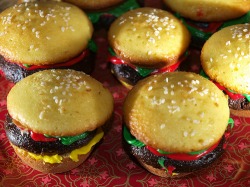
Plus - you'd have the possibility of cupcakes that look like cheeseburgers!
[Note - I have removed the links to the RootsBlog in this post. I'm in the process of setting up the blog for a new school year and I've erased last year's student posts. I've also temporarily removed the synopses of the episodes on the RootsBlog pages, so that students will be surprised when they see the movies in class. Sorry for any inconvenience.]
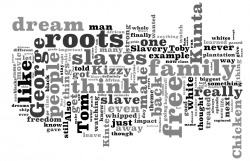 My classes' last activity before leaving on Spring Break this past week was watching the final episode of Roots.
Over the course of the year, the students have been watching episodes of the 1970s mini-series, then blogging about it in the voices of characters from the movie. (I posted a blog about this a few months ago.) As I say, they have just finished watching the whole series, and for their final blog entry, I asked them to write about what the series has meant to them as a whole.
I got some pretty thoughtful answers.
I had asked my students to try to identify a theme that ran through the series and was meaningful to them, and as I've been reading their responses, I've been wondering what the common theme of their experience has been. I decided to use another tool I posted about a few months ago - Wordle - to look for that theme.
Here's what I ended up with:
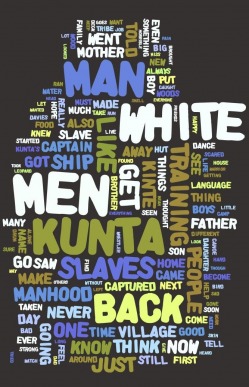 Episode One:
In this episode, the students met Kunta Kinte, a young boy growing up in a village in Gambia. They follow him through his Manhood Training and learn a little bit about his culture. At the end of the episode, he is kidnapped by slave traders and taken away from his people forever.
This was the first blog the students wrote. Some individual blog entries were spectacular, most not-so-much. As a first attempt however, it was pretty good. They were still getting the hang for this.
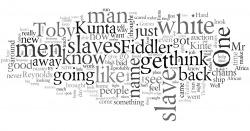 Episode Two:
In this episode, Kunta Kinte is taken to Colonial America and sold at auction. He is put to work on a plantation and punished until he is "broken". The most dramatic scene is the final one, where he brutally beaten until he answers to his slave-name "Toby".
This round of blog entries was much more on target. Students did a much better job of climbing inside the heads of characters from the movie. The writing was much more reflective. (There were a lot fewer entries that started with, "Hi. My name is...". When I read these entries, my faith in the project became a lot stronger.
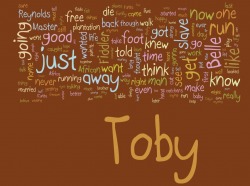 Episode Three:
This is the episode where the students got well and truly hooked.
In this episode, Toby (Kunta Kinte), now a grown man, tries to escape from slavery one more time. He is caught hand has half of his foot chopped off to keep him from running again. He is moved to a new plantation, where he slowly comes to terms with his life as a slave, marries and has a child.
By this set of blog entries, a few standout students were showing their talents as writers. Several of them were the high-achieving motivated students you would expect to excel at this sort of thing, but several were students who had slipped under my radar up until then - nice kids, but undistinguished scholars. This gave me a new perspective on them. (If you read any of these blogs - take a look at Catherine's or Drew's - very rewarding!)
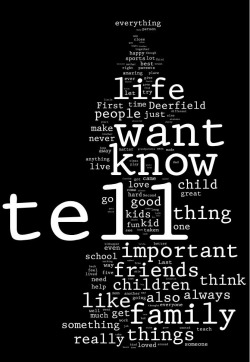 Episode Four:
This episode was a rough one for my students. Kizzy, Toby's daughter (born in the previous episode) is sold away from her family to a master who rapes her. She has a son who she raises as well as she can under the circumstances. She tries to find some happiness for herself, but finds herself trapped by slavery - emotionally as well as physically.
As they watched this episode of the movie, the students read a chapter from the book Roots by Alex Haley. In this chapter, Kizzy has to decide how much of her life history she should share with her son George.
Because this episode of the movie did not have a large number of characters to assign to students, I changed their assignment for this blog. After they had read Chapter 87 of Roots, I asked them to make the same decision that Kizzy had made - If they were taken away from they life here in Deerfield forever (abducted by aliens or something), what five things would they tell their children about their life to this point and why?
Some of the kids fell back on platitudes and general life advice, but most of them really embraced the assignment and looked at their lives in a way that they hadn't before. This may have been their most successful blogging assignment.
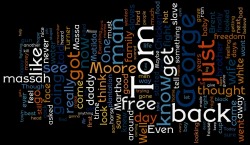 Episode Five:
In the last two episodes of Roots, Chicken George - Kizzy's son - really comes into his own and becomes something of a hero to the students in my class. These two episodes cover the years directly before and after the Civil War and how the lives of African-Americans in the South were affected by national events. The Reconstruction Period is particularly relavent to the students, because it deals with issues that are a little easier for them to relate to; slavery is very difficult for white kids in New Hampshire to wrap their heads around - out-and-out racism is (sadly) more familar.
By the time they wrote these character-point-of-view blog posts, the students had gotten the hang of what they were supposed to do. The writing came fairly quickly and pretty successfully. It was good work.
Episode Six:
As we wrapped up the final episode of Roots, I asked the students in my blocks to blog as themselves again. It was pretty clear that Roots had been a very popular unit, but I wanted to know what they had gotten out of it.
So far, about a third of the students have submitted their blog posts. (The deadline has passed, but I'm taking Spring Break into consideration.) When I have all their blog posts to draw from, I will run it through Wordle again and see what new themes emerge.
[Note - I have removed the links to the RootsBlog in this post. I'm in the process of setting up the blog for a new school year and I've erased last year's student posts. I've also temporarily removed the synopses of the episodes from the RootsBlog pages, so that students will be surprised when they see the movies in class. Sorry for any inconvenience.]
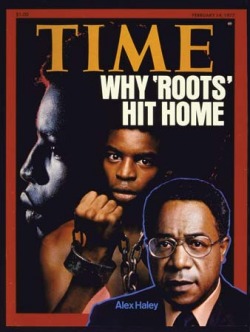 One of the most engaging activities each year in my 8th grade Social Studies class is watching the mini-series Roots. Our students are a very, very, VERY white group of kids, living in New Hampshire; for many of them, this is their first prolonged exposure to anything having to do with African-American history or culture. It is very gripping for them.
On the other hand, watching all six episodes takes up 3-4 weeks of classtime over several months. I've been trying to find some way to make watching this movie a less passive experience.
This year, the students are posting to a Roots blog.
After each episode of Roots, the students line up in front of the Awesome Jar of Destiny.
[A note of explanation: the Awesome Jar of Destiny is a technique I use when I'm assigning projects to our 8th graders. I have an empty 1-gallon mayonaise jar with slips of paper in it with all the possible assignments for a particular assignment. The students line up and each draws a slip of paper. They have five minutes or so to compare assignments with each other and trade assignments, if they want to. This adds an element of choice to their project and gives them a little more control over what they do. If a student really, REALLY doesn't like his or her project, he or she can draw a new one from the AJofD, but is then stuck with that project - no redraws, no trading, no nothing. (It's amazing how many students have taken that option this year.) After giving them a few minutes to look at each other's assignments, I have them sit down and I'll call their names from my gradebook, then write down each student's assignment and they are stuck with it. Even the really unmotivated students seem to agree that this is a fair way of doing things.]
For the Roots projects, each slip of paper in the AJofD has the name of one of the characters in the episode the students have just watched. Sometimes it is a minor character, sometimes a major one. In order to have enough characters for each of our 58 students to have his or her own character, some of the major characters are in the jar multiple times. For example: "Kunta Kinte as a boy before going through Manhood Training", "Kunta Kinte after Manhood Training, living in his village in Gambia", "Kunta Kinte after being captured and waiting to be loaded onto the slave ship", ect..
Each student is responsible for writing a short essay (250-1,000 words) about how his or her character felt about the events that went on in the episode, then post that essay to a blog.
After experimenting with a lot of different blogging platforms, I ultimately decided to go with Edublogs. It is not the most user-friendly blogging site around, but in the end, it had the flexibility I needed, without being TOO complicated. I set up seven blogs - one for each episode and one for the project instructions. In each episode blog, there is really only one post - a synopsis of the events of the blog. Each student posts his or her blog entry as a comment under the synopsis. Students can even comment on each other's comments.
All comments are moderated, which means that they get sent to me to check out before I approve them to be posted on the blog.
To protect students' privacy and to practice good internet safety, the students post their comments with their first names and last initials only, as well as the name of the character they are blogging as and the class they are in (to help me with my grading). If a student forgets and puts his or her last name in the blog post, I can catch it as I moderate the comments and edit it before posting it. When I do this, it gets posted under my name, so I put a little explanation at the bottom of the post explaining why it is posted under my name. This gives a pretty good nudge to offending students and they usually are more careful the second time around.
We try very, VERY hard to get parental permission to post student work online. An additional benefit of comment moderation is that for the students for whom we do NOT have permission, I can read their blog post, grade it, then simply not approve it to be posted online.
So far, my students have blogged on two of the six episodes of Roots. The first set of blog entries was a little rocky - which is to be expected for the first attempt at any project - though some individual entries were very good. The second round of blog posts was much, much better. While the spelling and grammar is still not where I'd like it to be, some of these blog posts were heart-breakingly good.
Judge for yourself:
Click here to read the students' instructions.
If you like what you read, please leave a comment to let the students know it. One of our Literacy standards in the 8th grade is writing for a larger audience than just a classroom. Blog comments are a good way for them to know that they are doing that.
The downside of all this is that I'm currently in the middle of showing them Episode Three and I suddenly realize that I don't have any of the little slips of paper written yet.
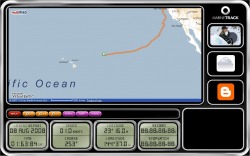 All summer, I have been listening to a really remarkable podcast - Roz Rows the Pacific.
A woman named Roz Savage, who rowed solo across the Atlantic Ocean a couple of years ago is currently rowing across the Pacific Ocean. If she succeeds, she'll be the first woman to do this. Her trip will be in three legs - San Francisco to Hawaii, Hawaii to Tuvalu and Tuvalu to Australia. Because she will obviously need to rest up between the legs of this trip, it will take a couple of years.
As I write this, she is a little less than a thousand miles from Hawaii - almost done with the first leg of the trip.
Because modern technology like satelite phones, gps units and the internet have all come down so much in price over the past few years, it is very easy to keep up with her progress. She has:
· A podcast that is updated three times a week, where Roz tells what happened to her at sea over the past few days. This is strangely compelling, especially considering that NOTHING much happens on a day-to-day basis: just rowing, rowing and maybe some more rowing (on most days, she doesn't even see birds). The more you listen to this, though, the more you end up thinking about her very tiny environment.
For instance, a few weeks into her trip, her watermaker broke down totally and completely; it will have to be replaced when she gets to Hawaii. It's not a trip-ending disaster; most of her ballast is made up of bags of fresh water, so she can drink her ballast throughout her trip, replacing it with sea water as she goes. This just means that she has to carefully consider each and every drop of water she uses. (Given that she rows twelve to fifteen hours a day, that is a very tricky balance to strike.)
· A blog - She updates a blog about once a day. (Again, fascinating in a zen kind of way - looking at the tiny details of her life at sea.)
 · A marine tracking website that updates her position, speed and course every day
 So, how does this relate to the classroom?
Hard to tell. If everything goes well, Roz will finish up the first leg of her trip sometime in early September - a little too early to make a viable class project out of this. She should start the second leg of the voyage next winter, which would give a teacher plenty of time to plan a good project around this.
Here are a few possible activities I see:
· Giving her latitude and longitude coordinates to students each morning and having them track her progress on a big classroom map. At the end of a particular period of time, this could be compared to the map generated by MarineTrack, the website that provides the coordinates.
· Mocking up a floorplan of her boat and planning out packing lists (sort of like the "What would you take with you in a covered wagon?" activity that many of us have used over the years.)
· Writing letters or emails as a class. One of the main reasons Roz is making this trip is to raise awareness of ocean conservation. There are some great writing assignments in there somewhere.
· Converting nautical miles to statute miles, knots to miles per hour, metric to imperial measurements, etc...
· Studying currents, prevailing winds, tides, storms and other weather systems.
· Learning just where the heck Tuvalu is and studying the history and geography of the islands of the South Pacific.
These strike me as really good projects for 4th-7th grades. (I suspect our 8th graders could never get past the idea of her going a couple of months without washing her hair or shaving her legs.)
|













 RSS Feed
RSS Feed